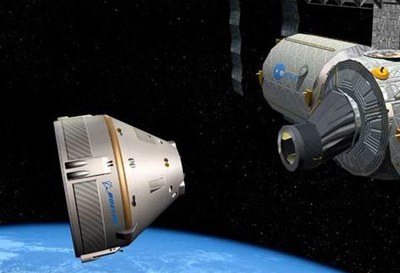US citizens: demand maximum support for NASA’s Commercial Crew Programby Rick Boozer
|
| Commercial Crew has the potential to do for American human spaceflight what COTS has already done for the American satellite launch industry. |
Politicians rerouted the remainder of the funds requested for Commercial Crew to a pork barrel project: a giant rocket referred to as the Space Launch System (SLS). Using obsolete Space Shuttle technology and antiquated contracting methods, SLS’s development costs are so high that there are no funds left to develop payloads for it, earning it the nickname of “The Rocket to Nowhere.” SLS also financially starves other needed technologies such as in-space filling stations (called propellant depots) that will be needed for advanced human flight into deep space. Worse, a study commissioned by NASA and done by Booz Allen Hamilton states that intermediate development goals for the giant rocket will probably be completed on time only within the first three to five years of development at its current level of funding; after which, development would slow drastically and the completion of the largest version of SLS would fall further and further behind schedule with no definite end in sight.
As an example of what such commercially-related efforts can achieve, another somewhat similar NASA effort, met with huge success. Under the Commercial Orbital Transportation Services (COTS) program, NASA partially funded development of two launcher/spacecraft systems (produced by the companies Orbital Sciences Corporation and Space Exploration Technologies, or SpaceX) to deliver supplies to the ISS. These two systems now deliver those supplies for much less cost than ever before. However, these vehicles can do much more. Their competitive lower pricing is allowing the US to regain a share of the international commercial satellite launch business that it all but lost to rival countries years ago. This resurgence of satellite business is poised to bring potentially billions of dollars into America’s economy. For example, SpaceX, which launched a communications satellite for European company SES last month, will launch a similar satellite for Thailand on January 6.
Commercial Crew has the potential to do for American human spaceflight what COTS has already done for the American satellite launch industry. Making human spaceflight much cheaper will lead to more human business activity in space, helping our nation’s economy to thrive. The three companies developing spacecraft under this program—Boeing, Sierra Nevada Corporation (SNC), and SpaceX—will offer individuals, industries, and other governments lower cost access to space that other countries would find difficult to match. Indeed, the German government is already funding a study of the practicality of using SNC’s Dream Chaser spacecraft for its human spaceflight operations.
But even if a rocket as large as SLS were truly needed, both United Launch Alliance (ULA) and SpaceX have given quotes to NASA for building rockets more powerful than even the largest version of SLS. Each quoted development funding amount was many billions of dollars less than the most optimistic projected total development costs for SLS. In at least one of those cases, the cost was to be fixed at the quoted amount in a contract.
| Cancelling work on SLS would allow more than enough funding for Commercial Crew to proceed at a reasonable pace, and enable the development of other new space technologies that NASA needs for the future. |
By the end of this summer, the Commercial Crew Transportation Capability (CCtCap) phase of vehicle development is scheduled to start. NASA’s Inspector General has indicated that if it is not funded at requested levels, the first crewed flight to ISS could slip another three years, to 2020. That would make five extra years of sending American dollars to Russia while Congress continues robbing Peter to pay Paul. It is even possible that Congress may force NASA to drop work on one or more of the participating vehicles. Given the serious interest in it that the Germans are showing, it would be ironic if SNC’s Dream Chaser was one that was dropped.
Please support the full funding of the Commercial Crew Program to prevent a humiliating and economically imprudent extension of US reliance on Russia for space taxi service, and to stop the unnecessary prolonged outflow of American taxpayer dollars to that other country. Such an action would also hasten the end of dependence on a foreign power whose interests are sometimes antagonistic to those of the US. Also, cancelling work on SLS would allow more than enough funding for Commercial Crew to proceed at a reasonable pace, and enable the development of other new space technologies that NASA needs for the future. If all of those steps are taken, NASA’s current overall funding levels are sufficient for it to do exciting cutting edge astronaut missions to the Moon, Lagrange points, a close asteroid, and eventually Mars, while also allowing ambitious robotic exploration of worlds beyond.
